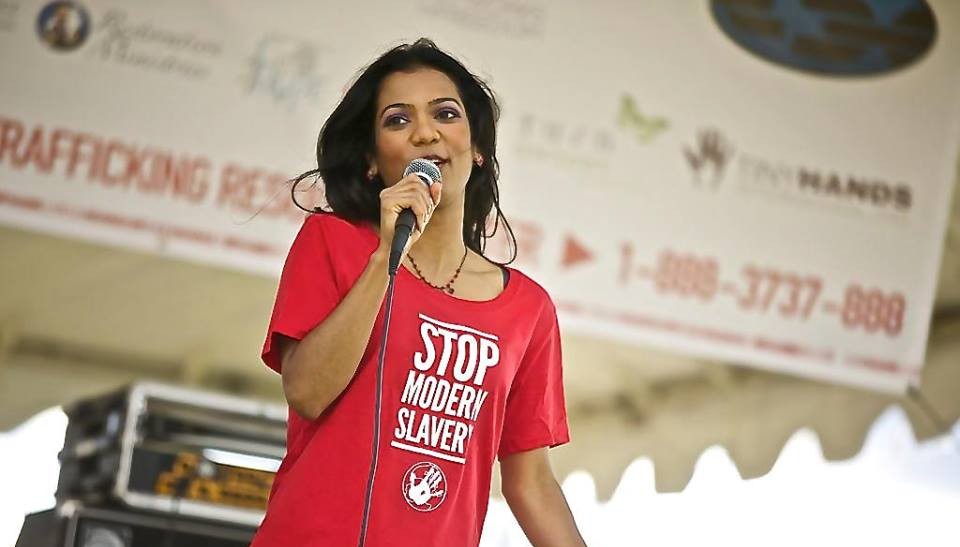Beauty queen taps pageant platform to tackle human trafficking
Mary David is used to turning heads. As both a former Miss Wyoming and more recently Ms Capitol Hill, Mary has rightfully shared the stage with some of the loveliest women in the world. But these days, the perennial pageant winner would rather turn hearts and lives around, as she works to help people escape the largely underground world of human trafficking. Through lobbying and lectures, volunteer work, TV appearances, performance art and poetry, Mary moves en pointe to get the message out to men and women living their lives in a shadow: There is hope, and victims of human trafficking should never feel ashamed. This coming Wednesday, Mary will be launching a new website geared, not only to helping those caught up in the trauma of trafficking, but also toward highlighting actions everyday people can take to be part of the overall solution. We sat down last week with Mary David to learn more about human trafficking and to talk about her ongoing efforts to make a difference in the lives of millions of people.
BPE ~ Thank you so much for sitting down with us today. To begin, it’s clear that human trafficking is an issue very dear to your heart. Did your interest in this issue come up when you were doing the beauty pageants?
Mary ~ Yes, I’m glad you brought that up, because my interest in pageants is very much aligned with my passion for fighting human trafficking. I was always interested in doing pageants – I thought they were cool – but I really didn’t have the time to dedicate to them until after I did a college study abroad program in Cyprus.
BPE ~ Why Cyprus?
Mary ~ I wanted to pick somewhere outside of the box, and I really didn’t know anything about Cyprus. One thing I definitely didn’t know anything about it was that there is a huge Philippino and Sir Lankan domestic worker population living there. They are the lowest class of people on Cyprus and are heavily discriminated against. So when I arrived, people didn’t know where I was from. They thought, ‘Well, her features don’t really look American, so she must be one of the domestic workers. I got hit with a lot of the discrimination the domestic workers often face. I was kicked out of places and accosted on the street. I was also physically attacked once, but the response from the police and other authorities was not very strong in terms of helping me get any civil recourse. This made me wonder, ‘If this is how I am treated, and no one has a problem with it, what are these domestic workers facing at home?’
 I developed a research program to find out and started meeting with the workers. Through that program, I learned that many of them had been trafficked – that is, brought into Cypress by some sort of coercion or trickery. I completed my project and presented my possible solutions to the government there, but then I came back to the US and realized that the same thing was going on here. That just shocked me to my core. I really wanted to do something about it, and not only in the context of how I’d seen it play out in Cyprus, but I thought, ‘Who is going to listen to me?’ I was in my early 20’s and worked for a non-profit in Cyprus, but aside from that I really didn’t have a background or a visible platform. People suggested I work with this non-profit or that one for several years first – you know, to get some name recognition – but that wasn’t fast enough for me. And then I thought, ‘OK – pageants. They send me information in the mail and there is always something about a platform.’ So I went for it and crafted my performance piece (a monologue) around the issue of human trafficking. It’s an issue which is dear to my heart and that’s the way I presented it.
I developed a research program to find out and started meeting with the workers. Through that program, I learned that many of them had been trafficked – that is, brought into Cypress by some sort of coercion or trickery. I completed my project and presented my possible solutions to the government there, but then I came back to the US and realized that the same thing was going on here. That just shocked me to my core. I really wanted to do something about it, and not only in the context of how I’d seen it play out in Cyprus, but I thought, ‘Who is going to listen to me?’ I was in my early 20’s and worked for a non-profit in Cyprus, but aside from that I really didn’t have a background or a visible platform. People suggested I work with this non-profit or that one for several years first – you know, to get some name recognition – but that wasn’t fast enough for me. And then I thought, ‘OK – pageants. They send me information in the mail and there is always something about a platform.’ So I went for it and crafted my performance piece (a monologue) around the issue of human trafficking. It’s an issue which is dear to my heart and that’s the way I presented it.
BPE ~ Along with being Miss Wyoming, you also competed locally as Ms. Capitol Hill?
Mary ~ Yes, and I loved representing the Capitol area, but I had to drop out after being accepted into a wonderful leadership program in Amsterdam. The dates I would be away conflicted with the finals for Ms. DC, so my reign kind of ended with the title Ms. Capitol Hill.
BPE ~ But going to Amsterdam was worth it?
Mary ~ It was! The experience has helped me frame the ideas I have and hone my skills as a leader.
BPE ~ Do you find when you travel now, you keep a weather eye out for human trafficking?
Mary ~ Absolutely. It’s something I try to be vigilant about, but at the same time not let it take over my life. I mean this happens everywhere; at after school programs, at the mall, in broad daylight, so it’s something that is on my radar – especially when I travel. I just wish people would do more when they see it happening. When I give talks on the subject, I tell people to keep their eyes open when they go to the airport, because that’s where a lot of the victims come in. If you see someone who is very stressed and nervous and appears to be controlled by someone, it’s not wrong to approach a stewardess or law enforcement officer and say, ‘I’ve got a funny feeling about this situation. Could you look into it?’ I have done that myself and thankfully at many airports now, it is recognized that this (human trafficking) does happen. I have even been there when they’ve pulled up flight information on a person who appeared suspicious and said, ‘Thanks, we’re going to take this to the authorities.’ You may never know what happens after that, but you play your part, and that’s the best thing to do.
BPE ~ Are there any hard statistics on how many victims there are and where they come from? If so, what is the breakdown between cheap domestic or farm labor vs forced sex trafficking?
Mary ~ The only thing I can tell you for sure is that statistics are almost impossible to nail down because it’s such a clandestine operation. People really try to keep this issue under the radar. There is also an element of organized crime at work there. But another problem is that victims often don’t self-identify. A girl may say, ‘Yes, I was taken from my house and taken to another country’ or, ‘I have an older boyfriend and he asks me to do certain things so we can make money, but he controls all the money I am given’; that sort of thing. But they don’t make the connection.

It’s funny. When I talk with models, they maintain they know nothing about human trafficking, but then they will say, ‘Yeah, I once posed for this photographer, and he asked me to do things I wasn’t comfortable with.’ Most people don’t realize that that’s actually another form of human trafficking.
But getting back to the question of numbers.
When you include the cheap or forced labor – farm workers, fishing, manufacturing, etc. – and add to that the men, women and children caught up in sexual exploitation, some estimates go as high at 27 million people worldwide.
BPE ~ What are the ages we’re talking about with the sex trafficking?
Mary ~ It’s about 50/50 adults to minors. In the US, the average age at which children get started in prostitution is 12.
BPE ~ How do children that young get caught up in prostitution?
Mary ~ In the US and other parts of the world as well, a lot of the child prostitutes are runaways. It could be that the kids have left home because of a bad domestic situation or the family is facing a monetary hardship and the child is sold to a trafficker. Some estimate that every 48 hours, one out of three children is approached by a trafficker.
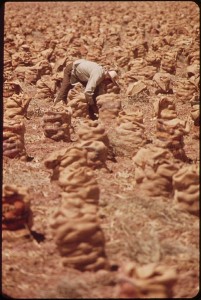
BPE ~ Has the recent influx of immigrants into the US added to the problem here?
Mary ~ Again, that is hard to say for sure, though anecdotal evidence would suggest that a lot of exploitation is taking place in the labor force.
BPE ~ You mentioned the aspect of organized crime. Is this just with the sex workers or are other areas also affected?
Mary ~ With organized crime, I was speaking mostly about the drug cartels, but the criminal aspect also breaks down along cultural lines. You might have a situation where everyone working in a nail salon has been trafficked. You’ll find people working out of a house or a storefront which distribute cards with a logo which indicates that that location is a place where say the Koreans or the Chinese or the Salvadoreans are the ones doing the trafficking.
BPE ~ Have you seen such cards?
Mary ~ I have seen them, yes. Unfortunately, I don’t have one with me that I can show you, but they are out there.
BPE ~ When we first spoke earlier this year, you were about to start a television project. Could you tell us a bit about the show?
Mary ~ Yes, the show I was working on was a pilot series called Free To Be You. The idea behind it is to highlight people who are making an impact in their community, touching on issues that are somehow related to human trafficking. It was part talk show and part performance space. That allowed us to bring in people and engage in in-depth discussions about the issues AND to advocate in a different way (and perhaps reach a different audience) with the performers.
One thing I discovered in my travels – particularly as it pertains to youth – is that to reach people you have to take a more holistic approach. The judges, legislators and policy makers all know what is happening. We want to reach people going to sporting events; going to the casinos; kids in after school programs – to make THEM aware of what may be going on all around them. You don’t necessarily reach people like that with a governmental policy or a prepared stump speech. You reach them with a poem, a song, drama, a dance number; something which jars their imagination. I hope someday the TV show is something I can do full turn.
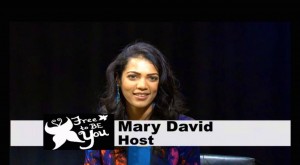
BPE ~ What are you doing in the meantime?
Mary ~ One issue that I’m very passionate about is exposing the link between aspects of shame and human trafficking.
BPE ~ Could you elaborate on this?
Mary ~ Sure. Often times, people wonder why someone stays in a cycle of trafficking; of abuse and exploitation. This may be a girl working in a brothel or someone doing domestic work in a home. Why don’t they walk away? There may be many different reasons, including a lack of trust; a lack of knowing what options you have. But a big part of it is shame. Imagine feeling like you are completely used; that you have nothing and no one in your life. There is no one to call or go home to. You may think, “No one cares about me”. If you left home because of a bad situation, what would you be going home to?
BPE ~ So the shame aspect is very damaging?
Mary ~ It is extremely damaging, but it’s also a way that sex traffickers keep people in bondage. They create a so-called safe place while breaking a person down, then initiate them into a cycle of exploitation and abuse. We’re talking about beatings and gang rapes where the victim is made to feel like they are nothing. Often they are left to feel like what has happened is actually their fault. When you bring the pieces all together, you can see how shame is used to keep a victim enslaved. Exposing that angle will not only help those on the outside to understand what’s going on, but also help people on the inside to see that they should not take on that shame. It helps with both the healing and the prevention process.
It’s an insidious problem.
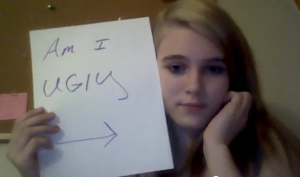
I’ve had people tell me that the first person who ever told them they were beautiful was the person who ended up trafficking them. How is it that a 13 or 14 year old girl could go through that much of her life and never be told she was beautiful? Not from anyone. That’s a damning indictment on our society. Just the fact that 10,000 people a month Google the phrase ‘Am I ugly?’ ties into the cycle of shame and exploitation. Everyone wants to feel valued, so when you do hear those words, it creates a psychological bond which is very hard to break.
BPE ~ If I’m following you here, it seems that the one contributing factor we can nail down is the absence of a caring father figure in so many homes today. Does that indeed play a part in this issue?
Mary ~ Absolutely. If children do not have someone in their life whom they can look up to, then it’s easy to fall for a smiling trafficker. There are definitely links between children raised in a home where that strong father figure is missing and the feelings of shame and worthlessness which lead to trafficking.
BPE ~ A term came to mind as you were talking about the difficulty people have with leaving their abusers: Stockholm Syndrome. Are you familiar with that term and do you think it may apply in these types of situations?
Mary ~ Yes. I believe that sometimes happens – that there is this strong trauma bond. The difference I would say is in the length of the relationship. Traffickers will often scout their victims for months if not years and really work to develop a relationship with the person they are going to traffic. They’re very strategic about that process. It may be 2-3 months of simply watching the victim, then another 2-3 months of cultivating a relationship. The victim believes they really know this person and can trust them, so they have this view of the person as they have seen them outside of the trauma, and they are trying to go back to that phase where the trafficker was trying to romance them.
BPE ~ So it’s not just some creepy guy hanging around a bus station waiting to take advantage of some lost-looking girl?
Mary ~ No, but that does still happen. A guy will say, “You don’t have anywhere to go. You can stay with me for a few days; maybe a month or two.” They give them a room and food and clothing, and the victim thinks, “This person is awesome”. But you also have that person in the neighborhood a victim may pass on the street while walking home from school. If you see them often enough, you don’t perceive them as a threat.
BPE ~ You’ve talked about how difficult it is for a person to leave a trafficking situation, but what happens when they do decide to come out? What is the process?

Mary ~ The healing process has many layers. One of the first things involves getting their priorities in order. Where am I going to live? How am I going to support myself. But before you can do this, you have to get the social aspect in order. That’s where restorative homes are so important – particularly if there are children involved.
If a victim went out on the street at 12 and wants to come out at 16, that’s a four year gap in education and learning social skills, and that’s huge. For older victims, something as simple as balancing a checkbook must be learned. Interviewing for a job? Most don’t even know how to LOOK for a job. So, it’s important to learn what kind of resources are available. Again, the victim must overcome that shame aspect and build a supportive network around them. They have to get beyond the feeling of, “How is anybody going to ever see me as anything more than this?” Getting that hope back; the sense of curiosity in life is just so important.
A lot of the victims also have to rediscover who they are.
They’ve been given new names by the trafficker and told they would be killed if they ever used their real name again. So, they’ve lost touch with what they used to like; what their favorite color is. They don’t know pop culture, so integrating all of those aspects is a huge step. There’s a home here in Maryland called The Samaritan Women which offers a year long residency for women coming out of trafficking. The program there helps with the reintegration process.
BPE ~ What age range does Samaritan Women serve?
Mary ~ Samaritan Women is not so much age specific, but it is for adult women who are far enough along in the healing process that they can commit to a twelve month program. One of the struggles victims have is to be in one place and not feeling like they have to run, because they are so used to running. Another struggle is talking about their trauma. If you’ve been through a breakup or a divorce, you know that talking about it can be part of the healing process. Magnify that by a million and you’ve got what victims of trafficking are dealing with.
Courtney’s House and FAIR Girls are two of the havens in D.C. Safe House of Hope and Turnaround are two more places in Baltimore which offer some types of services, but housing is always a source of concern for both victims and advocates.
BPE ~You’ve mentioned several places for women. What about places for boys and men?
Wow, we really need more resources for boys and men. One place which comes to mind is Urban Light in Silver Spring. There are other places like the Salvation Army and Catholic Charities who have been substantial partners. Serving families who naturally want to stay together can also be a challenge.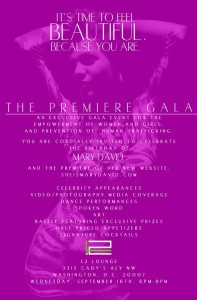
If I may add, volunteering at any of the organizations that I mentioned is huge. There is a wonderful play about a woman who was trafficked in the US for sex, called 7 Layers Captive that is being done at The Kennedy Center October 10. I know the writer of this story, and we both believe that art is a powerful tool, not only in explaining human trafficking but also in helping people who want to come out. I’d also like to add that this Wednesday, September 16, I’m hosting a launch event for my new website, called She Is Mary David. For the launch, we are having a gala affair at L2 lounge in Georgetown. We have different featured guests lined up, along with a few beauty queens and TV personalities. I will be performing as well, doing spoken word poetry. There will be some dance performance, too, and of course the launch of the actual website. So everyone should come. It will really be a spectacular event. You should come too!
BPE ~How could we resist? One last question: What would you say to someone who wants to come out of human trafficking?
Mary ~ I would say I am proud of you – you are so strong. There is no reason to feel ashamed. You are not to blame, and there is hope.

Anthony C. Hayes is an actor, author, raconteur, rapscallion and bon vivant. A one-time newsboy for the Evening Sun and professional presence at the Washington Herald, Tony’s poetry, photography, humor, and prose have also been featured in Smile, Hon, You’re in Baltimore!, Destination Maryland, Magic Octopus Magazine, Los Angeles Post-Examiner, Voice of Baltimore, SmartCEO, Alvarez Fiction, and Tales of Blood and Roses. If you notice that his work has been purloined, please let him know. As the Good Book says, “Thou shalt not steal.”

